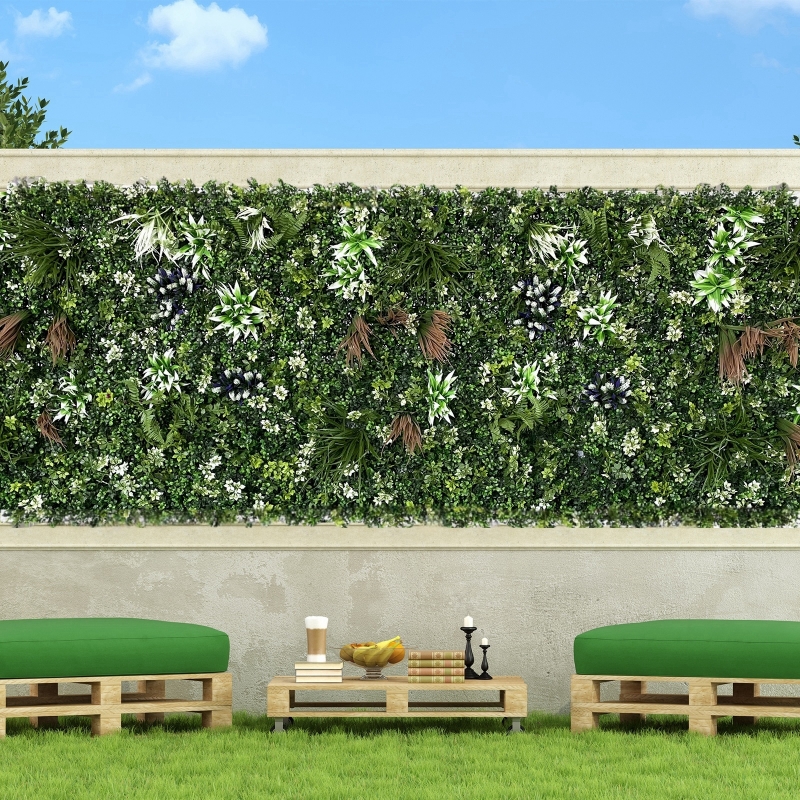3D artificial vertical gardens are widely and flexibly applied in outdoor environments. They can make full use of limited Spaces, enhance the level of urban greening, improve the ecological environment, and at the same time add unique landscape effects to buildings. The following analysis is carried out from several aspects including application scenarios, advantages, technical features and design key points:
Application scenarios
Commercial buildings: Setting up vertical gardens on the exterior walls, atriums or rooftops of commercial buildings can beautify the building's appearance, attract customers and enhance commercial value. For instance, some shopping malls or hotels create green themes through vertical gardens to enhance brand recognition.
Residential buildings: Setting up vertical gardens on the balconies, walls or public areas of residential buildings can improve the living environment of residents, provide leisure Spaces, increase green areas at the same time and enhance the quality of the community.
Office buildings: Setting up vertical gardens on the exterior walls or in the indoor atriums of office buildings can create a comfortable working environment for employees, relieve stress and improve work efficiency.
Public facilities: Setting up vertical gardens in public facilities such as subway stations, bus stops and Bridges can beautify the urban environment, enhance the quality of public Spaces, and at the same time provide citizens with green rest areas.
Municipal landscape: Setting up vertical gardens in municipal landscapes such as urban squares, parks and streets can enrich the forms of greening, increase the green volume of the city and improve the microclimate of the city.
Advantage
Expanding green space: In cities where land resources are tight, vertical gardens can fully utilize three-dimensional Spaces such as walls and rooftops, increase green areas, and enhance the city's greenery.
Improving the ecological environment: Vertical gardens can absorb harmful substances in the air, release oxygen, reduce noise, regulate temperature and humidity, improve the microclimate of the city, and enhance the quality of the ecological environment.
Beautifying the appearance of buildings: Through the natural beauty and color variations of plants, vertical gardens can add a unique landscape effect to buildings, enhancing their artistic value and visual appeal.
Energy conservation and emission reduction: Vertical gardens can provide insulation and heat preservation effects for buildings, reduce the use of air conditioners and heaters, lower building energy consumption, and achieve energy conservation and emission reduction.
Providing leisure Spaces: Setting up vertical gardens in public areas or residential buildings can offer citizens green rest areas, promote social interaction and enhance the quality of life.
Technical characteristics
Modular design: Vertical gardens typically adopt a modular design, which is convenient for installation, maintenance and replacement. The modules can be flexibly combined according to the architectural structure and design requirements to form diverse landscape effects.
Automated irrigation system: To ensure the healthy growth of plants, vertical gardens are usually equipped with an automated irrigation system that can automatically adjust the amount and frequency of irrigation according to the needs of plants and weather conditions.
Lightweight cultivation substrate: Vertical gardens use lightweight cultivation substrates to reduce the load on the building structure while ensuring the air permeability and drainage of the plant roots.
Plant diversity: By choosing plant varieties with strong adaptability and high ornamental value, vertical gardens can achieve a landscape effect with beautiful scenery throughout the four seasons and rich colors.
Key points of design
Adapt to local conditions: When designing a vertical garden, it is necessary to fully consider local climatic conditions, light conditions, building structures and other factors, and select appropriate plant varieties and cultivation techniques.
Structural safety: The installation of vertical gardens must ensure the safety of the building structure to avoid causing damage to the building. Professional structural calculations and installation designs are required to ensure the stability of the garden.
Convenient maintenance: When designing, the later maintenance of the vertical garden should be taken into consideration to ensure that the irrigation system, plant replacement and other operations are convenient and reduce maintenance costs.
Landscape coordination: The design of vertical gardens should be in harmony with the architectural style and the surrounding environment to create a unified landscape effect and avoid being jarring or uncoordinated.

Contact: Amy
Phone: 86-15311787313
E-mail: info@foszmac.com
Whatsapp:86-15311787313
Add: Fengtai District, Dacheng Road, No.24 Building, Room 203, Beijing, China